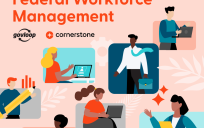On March 15, 2020, the Office of Management and Budget (OMB) asked federal agencies in the D.C. area to move to maximum telework. The memo was one of the first dominos to fall in the 14 odd months that followed.
Prior to the order, telework was generally available for those few and fortunate in the federal government, and by and large, state and local governments viewed it similarly – as a luxury or contingency plan. At maximum, 10 to 15% of state and local employees regularly teleworked prior to the pandemic, suggested Elton Fontaine, Sr. Systems Engineering Director for Palo Alto Networks, a technology partner of many agencies.
Though government dabbled in work flexibility before 2020, telework remained – in some ways – taboo.
“People who never worked remote always thought that people who worked remote were just partying,” said Nikhil Deshpande, the Georgia Chief Digital Officer.
Teleworkers aren’t black sheep anymore. Even as offices reopen, a majority of those attending GovLoop’s Wednesday webinar, where Deshpande and Fontaine spoke, were still working from home, according to survey results.
But all this time later, many workplaces still haven’t grasped what it means to telework. A dream setup in the eyes of many prior to the pandemic, telework has since led to higher reports of burnout, and many employees find themselves working harder from home than they would have in the office.
“I’ve started seeing the cumulative effect of burnout,” said Fontaine.
Instead of partying, employees have plugged in – and not always in the best way.
As the workforce settles into a to-be-determined shape comprising telework, offices and everything in between, Deshpande and Fontaine urged agencies to adopt policies that cater to a hybrid environment. As opposed to applying office expectations and protocols to the remote world, some simple expectation-setting can go a long way in an arena where the rules are yet to be written.
Take the anxiety out of Slack
One reason employees have reported working harder is they feel accountable for every second of the workday. Unwinding with a colleague or going for a walk were regular occurrences in the office, but with a constant barrage of messages on Slack – an instant messaging collaboration platform – or similar apps, employees feel guilty walking away.
This is on managers, Fontaine said. Work flexibility and independence are musts if employees are going to thrive long-term in a remote environment.
“It’s acceptable if I don’t get a response for an hour or two hours,” Fontaine said.
Enforce time off
During the pandemic, time off seemed somewhat pointless. Vacation was limited to a few activities and places, and the only recourse was staring at another screen – just like at work.
More than before, people took to keeping tabs on their work emails and messages during vacation. As COVID-19 conditions improve but burnout builds, leaders should make sure people are taking their time off, Fontaine said.
Create flexibility in hours
Now is the perfect time to let employees work when they’re at their best. Without rush hour traffic and office amenities, everybody is working on different assignments at different points of the day.
That can actually be a boost for productivity – personally and for the mission. Whether it’s for family, responsibilities or personal preference, people can get more done when they have flexibility when they work. Deshpande said in the new work environment, one employee asked him to relay anything important after 10:30 a.m., because that’s when their brain “started working.”
Offices can also have more staff online at any given time too. So if a surge of late-night requests pours in, during telework and with a geographically dispersed staff, more people will be online to respond.
For those worried about losing time to sync on meetings, don’t worry. A perfectly acceptable option is requiring all employees to still be online for a chunk of a few continuous hours every day, during which meetings can be scheduled and collaboration can improve.
“You cannot think in a format of a 9 to 5, because the biggest thing right now is to be flexible,” Deshpande said.
This online training was brought to you by:






Leave a Reply
You must be logged in to post a comment.